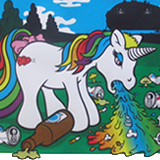|
Platystemon posted:Yeah but monobloc engines look boring. Those are some pretty amazing engines. The whole "stationary engine" thing is a mess of amazing hardware. When you need to build an engine that needs to run forever, and be as brutally economical as possible, you see some neat adaptations. Oil cooled pistons, that have a hundred jets to cool the whole piston face evenly. Crossslides to prevent any uneven cylinder wall loading. massively insulated exhausts to ensure all the energy gets to the turbocharger. Heat recovery systems, so you can run a steam, or at least hot water system off the exhaust. Big heaters to keep the engine at operating temperature even when not running. And so on.... Sagebrush posted:If they could turn fast enough to spin a propeller you're talking about 10,000 horsepower. At auto engine speeds 20-25,000. If only it scaled that way. Piston speeds become a problem, so does cooling, and so does the ability to flow enough air. R-Type posted:The Lycoming O-360 is practically a large displacement ancient VW beetle/van motor that costs a loving grip to rebuild. loving FAA can go spin its collective rear end in a top hat on a rusty spike. A turbocharged Subaru engine with conversion and a prop gear box does fine. The problem is more "industry" than FAA. Certifying an engine is not easy. Convincing someone they want to use an un-proven engine is even harder. Then putting your company under the financial risk of certifying anything is hard to do too. Toyota tried to get an engine certified in the early 90's. But they gave up on that project. The market is to small for the potential reward. The experimental market, however, is full of interersting engines. And some of them are even ~really darned reliable~. sanchez posted:The more modern Rotax and Jabiru piston engines aren't shining beacons of reliability either, I think any single engine piston flight is inherently a bit sketchy regardless of manufacturer. The guy flying a KR2 around the world, ended up with a Jabiru in his plane. I was talking to him about it two years ago, and he had nothing to say but bad things about those motors. They made weight... but were delicate due to it. $24k to re-do an airplane motor is highway robbery. At least from a "mechanics point of view". Most of that cost is insurance and dealing with the very low volumes of motors. *sighs* The private flight industry needs something done to make it the size it was in the 50's and 60's. PT6A posted:Correct me if I'm wrong, but isn't the main problem isn't that these engines need some amount of lead for whatever reason, but rather that no one's been able to formulate 100-octane fuel that has the appropriate physical characteristics for aviation use while also being economical to produce? The "real issue" is the plane was certified on 100ll. And if you run it on ANYTHING ELSE the data for running the engine is now bunk. Cheap fuel these days is auto gas, and that has at least some detergent and alcahol in it. That leads to some other issues with rubbers, fiberglass and fuel vaproization pressures. They're not big issues, but "things you need to be aware of". And really do need some testing to certify. quote:Another problem is that, although there are piston engines that run on Jet A now, they aren't attractive to training fleets because you have to convert the entire fleet at once or buy a new fuel tank. quote:We have fuel-injected engines now that avoid the issue of carb icing, and I can't imagine a circumstance where one wouldn't have to worry somewhat about engine temperature. Short of liquid-cooling systems, which are heavy as gently caress, you're always going to have to be somewhat mindful of how power, temperature and airflow are interacting to cool your engine. The rotax motors are water cooled for good reason. wolrah posted:A lot of commercial generators use engines from the automotive world. I think these would be a good example of what sort of power output you can reliably get from one of these engines under a continuous load. That cuts both ways. That limitation is part the generator, and part the motor. 1800rpm is very low, even for an american v8. But 1800rpm is a really good number for a generator. A better comparison, with better duty cycle comparison is marine application. If you want to know what a chevy v8 can do continuously, look at what mercuriser sells.
|
|
|
|

|
| # ? Jun 7, 2024 18:17 |
|
Platystemon posted:Yeah but monobloc engines look boring. Just want to add my gratitude for sharing this, it is wonderful.
|
|
|
|
There's quite a few interesting alternative engine reports made by accident investigation authorities, but none are really conclusive as to which system is better than the other, because not enough people have killed themselves to give us a statistically significant body of data. But here's an interesting Australian one, in which the Australian engine maker Jabiru gets torn a couple new exhaust holes. https://www.atsb.gov.au/media/5769864/ar-2013-107-final-report.pdfR-Type posted:The Lycoming O-360 is practically a large displacement ancient VW beetle/van motor that costs a loving grip to rebuild. loving FAA can go spin its collective rear end in a top hat on a rusty spike. A turbocharged Subaru engine with conversion and a prop gear box does fine. This is a huge can of worms in the kitplane community. Has been for decades. Subaru installations are less reliable than Lycoming. It's mostly to do with auxiliary systems, which is sad because when a fresh convert looks at the numbers, he only looks at the theoretical reliability/overhaul cost/fuel economy numbers from the original idea, not the accident rate of the ones that have tried before. Because those guys were all idiots right? He can just rub the magic nikasil coating and he will not make the same mistakes as all the "Fatal (1)"-people in NTSB reports. Safety Dance posted:If my 24 Hours of Lemons experience is any indication, maybe two hours at at time.  PT6A posted:Speaking of differences between aviation engines and car engines, does anyone know why maintenance intervals and break-in periods for automotive engines are given in distances instead of hours? Presumably highway miles are way easier on all a car's systems than the equivalent distance driven in the city. Is it just because cars don't have the equivalent of a Hobbs meter? Because there's a distance meter on the dashboard. Appeasing consumers that hate car maintenance is a much higher priority for car makers than optimizing car maintenance. Offroad motorcyles and tractors have hour counters and hour based intervals, it would work just fine but it's a habit thing.
|
|
|
|
PT6A posted:Speaking of differences between aviation engines and car engines, does anyone know why maintenance intervals and break-in periods for automotive engines are given in distances instead of hours? Presumably highway miles are way easier on all a car's systems than the equivalent distance driven in the city. Is it just because cars don't have the equivalent of a Hobbs meter? Nerobro posted:That cuts both ways. That limitation is part the generator, and part the motor. 1800rpm is very low, even for an american v8. But 1800rpm is a really good number for a generator.
|
|
|
|
Nerobro posted:That cuts both ways. That limitation is part the generator, and part the motor. 1800rpm is very low, even for an american v8. But 1800rpm is a really good number for a generator. 3600 is also a good number. edit: for a synchronous motor electric frequency = rotational speed (rpm)* poles/120. 1800 * 4/120 = 60 hobbesmaster fucked around with this message at 18:04 on Mar 21, 2018 |
|
|
|
Nerobro posted:The "real issue" is the plane was certified on 100ll. And if you run it on ANYTHING ELSE the data for running the engine is now bunk. Cheap fuel these days is auto gas, and that has at least some detergent and alcahol in it. That leads to some other issues with rubbers, fiberglass and fuel vaproization pressures. Avgas is special not because of itís octane content, but because of its predictable vapor pressure. Autogas of equivalent octane simply isnít as precisely refined, and can result in unpredictable vaporization at altitude. This is obviously an issue. However: These older regulations were largely written when even the largest commercial aircraft were still burning avgas, and burning it in extremely high performance turbosupercharged and turbocompound radials, cruising in the flight levels. An O-360 in a C-172 or an IO-550 in a Bonanza is never in a million years going to encounter an issue with ALCOHOL FREE mogas. And thus we talk about corngas. Not a single part of aviation is compatible with ethanol. Every single seal, gasket, o-ring, phenolic spacer, rubber fuel bladder, and drop of fuel tank sealant would need to be replaced with a certified substitute, requiring probably about three dozen STCs per aircraft type. Itís never going to happen. Not ever. gently caress ethanol-blended Mogas forever and ever. If I wanted to subsidize corn farmers, Iíd drink more CocaCola. The final destination is some form of 100 octane unleaded, but thatís a tough target for an aviation fuel, and there is very little (almost no) market pressure to introduce it.
|
|
|
|
wolrah posted:Ford put an hour meter on the Super Duty trucks in 2005 and the police package Crown Vic in 2006. I think the trucks measure total hours, the Crown Vics only measure time spent idling in park. I assume the new Taurus/Explorer police packages maintained this feature. quote:A fair point, the modular motors do really like to rev. Looks like a Cummins 6BT, the same motor you'd find in a Dodge Ram up to 1998, is rated for 215 HP @ 2500 RPM in a truck, 180 HP @ 2600 RPM "medium continuous" duty in a marine application, or 154 HP @ 1800 RPM in a 100kW generator. hobbesmaster posted:3600 is also a good number. MrYenko posted:All 100% correct Yup.
|
|
|
|
MrYenko posted:Not a single part of aviation is compatible with ethanol. Russian flight crews say otherwise.
|
|
|
|
MrYenko posted:Not a single part of aviation is compatible with ethanol. "Higher end" airline travel say otherwise.
|
|
|
|
Just mix colored water in with the E10, let it settle then drain out hte colored bits! No problem, ethanol-free gasoline! (don't do this for an airplane)
|
|
|
|
mekilljoydammit posted:Just mix colored water in with the E10, let it settle then drain out hte colored bits! No problem, ethanol-free gasoline! Just use blue if itís an airplane
|
|
|
|
PT6A posted:Speaking of differences between aviation engines and car engines, does anyone know why maintenance intervals and break-in periods for automotive engines are given in distances instead of hours? Presumably highway miles are way easier on all a car's systems than the equivalent distance driven in the city. Is it just because cars don't have the equivalent of a Hobbs meter? There's a handy display for looking at mileage...usually not for hours. You're also supposed to vary the type of driving according to every car I've ever bought. Edit: Oh hey there's another page. Godholio fucked around with this message at 20:42 on Mar 21, 2018 |
|
|
|
Now I want to put a Hobbs meter in my car. And maybe a directional gyro.
|
|
|
|
StandardVC10 posted:Now I want to put a Hobbs meter in my car. And maybe a directional gyro. Yeah but where you gonna put the flux valves?
|
|
|
|
e.pilot posted:the complete lack of technical advancement in aviation piston engines in the last 50+ years is beyond frustrating Umm, there has been quite a bit of advancement in the last few years. Lycoming makes a fully electronically-controlled O-540 variant (with FADECs and automotive-style port fuel injection) that is no more difficult to operate than the engine in your car.
|
|
|
|
It probably shouldn't cost as much as a Toyota Corolla to overhaul the engine in what is supposed to be a flying Toyota Corolla
|
|
|
|
Phanatic posted:Chevyís 307 smallblock put out as little as 115. Nerobro posted:And not the 150hp v8 out of the grand marquis? *shivers* Also high five So a little while ago I started building a model of a Dodge Ramcharger. The Ramcharger for those of you who use Oh, and if the V8 was still too much, you could get Dodge's indestructible slant six that made - 90? 100 HP?
|
|
|
|
Sagebrush posted:It probably shouldn't cost as much as a Toyota Corolla to overhaul the engine in what is supposed to be a flying Toyota Corolla the key difference is the inclusion of the adjectival "flying"
|
|
|
|
Something something flying Pinto
|
|
|
|

|
|
|
|
Nerobro posted:The rotax motors are water cooled for good reason. The 4-cylinder Rotaxes (912/914/915) only have water cooled heads, the cylinders are still air-cooled.
|
|
|
|
Ola posted:There's quite a few interesting alternative engine reports made by accident investigation authorities, but none are really conclusive as to which system is better than the other, because not enough people have killed themselves to give us a statistically significant body of data. But here's an interesting Australian one, in which the Australian engine maker Jabiru gets torn a couple new exhaust holes. https://www.atsb.gov.au/media/5769864/ar-2013-107-final-report.pdf Angry rant aside, I get it. You can't pull over the the closest cumulus cloud and get out and pop the hood when a hose busts. The Lycoming air cooling eliminates an entire cooling system to gently caress with. It also has dual-path spark and usually survive a cylinder eating itself long enough for you to pitch it in Farmer Bob's corn field. Do I think its worth 24K for a rebuild... nope. My uncle runs a hotshot service between Albuquerque - El Paso and Austin/San Antonio and all points in between for practically any kind of freight that is legal to carry. The rebuild cost is pretty drat steep, for that matter all the parts are ridiculous for what they are. On one hand, prohibitive costs help keep a lot of retarded shitheads from owning and flying planes that have no chops to ride a bicycle. But at the same time it really keeps private aviation out of a lot of people's reach, and makes operating costs a pain for small time operators. I like options and I think there can be some middle ground within reason that can be safe and cost effective.
|
|
|
|
ehnus posted:The 4-cylinder Rotaxes (912/914/915) only have water cooled heads, the cylinders are still air-cooled. That's the part that really matters. :-)
|
|
|
|
MrYenko posted:And thus we talk about corngas. Not a single part of aviation is compatible with ethanol. Every single seal, gasket, o-ring, phenolic spacer, rubber fuel bladder, and drop of fuel tank sealant would need to be replaced with a certified substitute, requiring probably about three dozen STCs per aircraft type. Itís never going to happen. Not ever. Obviously ignoring the certification aspect for that specifically in the case of aviation models, I 100% understand why the various companies involved wouldn't want to bother with that if they didn't have to. Also ignoring any opinions about alcohol-blend fuels on their own, that's an entirely different matter where I think we'd generally agree. Nerobro posted:for Diesels, I remember hearing an interview that the "real measure" is how much fuel the engine processed. Hours are better than miles, and fuel is better than hours. quote:That all sounds about right. A really good way to determine how "good" an engine is, is to check out the amount of torque it makes per cubic inch of displacement.
|
|
|
|
wolrah posted:Makes sense, especially for diesels. Hell even in my gasoline-powered BMW the oil change display has a readout in miles which is actually calculated based on the amount of fuel injected. Drive the car harder and it counts off at more than one mile per mile. I always wondered how cars did that.
|
|
|
|
wolrah posted:So this is something that bugs me about a lot of older engine designs still in production, not just in aviation I see it in power yard tools and other similar applications as well that alcohol blend fuels are not recommended. Is it really that much harder or more expensive to use alcohol-compatible seals? Are there not direct "drop-in" replacement materials available, like do they actually perform differently where there's a functional advantage to using incompatible ones, or is it just a cost thing? Certifying aircraft engine components is slightly different (and much more expensive) than Holley redesigning bowl gaskets and o-rings.
|
|
|
|
e.pilot posted:I always wondered how cars did that. Itís just not just fuel used, itís a bunch of drivetrain-related sensors picking up rpm, temperature, ambient temp, number of starts, engine load, etc., coupled with a predictive model for oil breakdown.
|
|
|
|
wolrah posted:So this is something that bugs me about a lot of older engine designs still in production, not just in aviation I see it in power yard tools and other similar applications as well that alcohol blend fuels are not recommended. Is it really that much harder or more expensive to use alcohol-compatible seals? Are there not direct "drop-in" replacement materials available, like do they actually perform differently where there's a functional advantage to using incompatible ones, or is it just a cost thing? It's not just the seals, though that's an issue... a lot of seals were designed when MTBE was the oxygenating compound. There's seal materials that are happy with gasoline, ethanol, and MTBE, but getting one that's happy with 2 out of 3 is bad enough, 3 out of 3 is almost impossible. But it's also just straight corrosion and oxidation reactions that gunk things up. I mean yeah, it's a cost thing, but almost all carburetors on small stuff are made out of zinc alloys because it's cheap. Well, zinc alloys are corroded by E10 one way or another... but between "well, it'll just die eventually, that's the consumer's problem" or "let's retool the production line that's been running for decades for a new alloy" guess which wins.
|
|
|
|
https://twitter.com/rebeccaballhaus/status/976866444532207616
|
|
|
|
Max Barry was tragically prescient again.
|
|
|
|
Some part of me wants to imagine Lockheed's stock price tanking after that.
|
|
|
|
haha holy poo poo
|
|
|
|
"yes mister president, that is correct. In fact there is one parked right behind you at this very moment!"
|
|
|
|
marilyn lockHEED
|
|
|
|
Finger Prince posted:"yes mister president, that is correct. In fact there is one parked right behind you at this very moment!" "I get a free one, right? Boeing gave me a free Super Horny. Put my name onnit and *everything*."
|
|
|
|
e.pilot posted:the complete lack of technical advancement in aviation piston engines in the last 50+ years is beyond frustrating To be fair, WWII probably advanced aviation piston engine technology by about 100 years
|
|
|
|
FuturePastNow posted:To be fair, WWII probably advanced aviation piston engine technology by about 100 years It advanced engineering that much. Not engines directly. Metalurgy, and testing methods were the biggest things. High speed photography, sensor suites, and materials testing. It was important that any two things made actually had similar performance, not "more" performance. It wasn't till late in the war that they really started pushing the edges of technology. Even then, real development didn't finish until the 50's.
|
|
|
|
  Itís really just a transponder glitch. Should be A2DCEE, an A330.
|
|
|
|
Good news for when we're all rich: http://www.abc.net.au/news/2018-03-21/replica-spitfire-pilot-soars-with-success-after-given-ok-to-fly/9571706quote:Replica Spitfire pilot soars with success after given okay to fly to work 365 days a year
|
|
|
|

|
| # ? Jun 7, 2024 18:17 |
|
drunkill posted:Good news for when we're all rich: http://www.abc.net.au/news/2018-03-21/replica-spitfire-pilot-soars-with-success-after-given-ok-to-fly/9571706 loving nimbys.
|
|
|













































